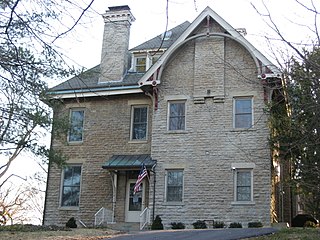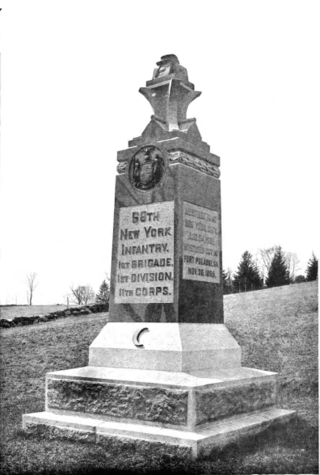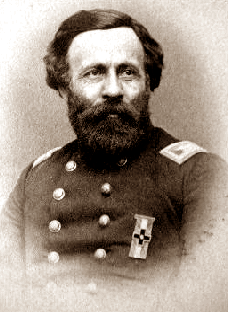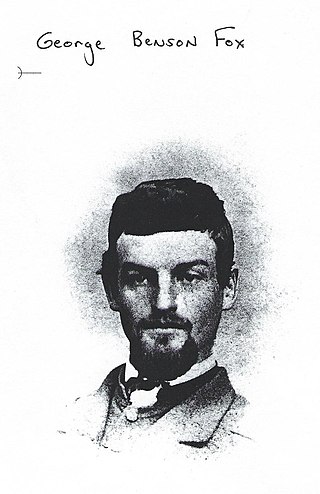
The Battle of Chancellorsville, April 30 – May 6, 1863, was a major battle of the American Civil War (1861–1865), and the principal engagement of the Chancellorsville campaign.

Francis Channing Barlow was a lawyer, politician, and Union General during the American Civil War.

The XI Corps was a corps of the U.S. Army during the American Civil War, best remembered for its involvement in the battles of Chancellorsville and Gettysburg in 1863. The corps was composed primarily of German-American regiments.

There were five corps in the Union Army designated as II Corps during the American Civil War. These formations were the Army of the Cumberland II Corps commanded by Thomas L. Crittenden from October 24, 1862, to November 5, 1862, later renumbered XXI Corps; the Army of the Mississippi II corps led by William T. Sherman from January 4, 1863, to January 12, 1863, renumbered XV Corps; Army of the Ohio II Corps commanded by Thomas L. Crittenden from September 29, 1862, to October 24, 1862, transferred to Army of the Cumberland; Army of Virginia II Corps led by Nathaniel P. Banks from June 26, 1862, to September 4, 1862, and Alpheus S. Williams from September 4, 1862, to September 12, 1862, renumbered XII Corps; and the Army of the Potomac II Corps from March 13, 1862, to June 28, 1865.

The first day of the Battle of Gettysburg during the American Civil War took place on July 1, 1863, and began as an engagement between isolated units of the Army of Northern Virginia under Confederate General Robert E. Lee and the Army of the Potomac under Union Maj. Gen. George G. Meade. It soon escalated into a major battle which culminated in the outnumbered and defeated Union forces retreating to the high ground south of Gettysburg, Pennsylvania.
The 8th Ohio Infantry Regiment was an infantry regiment in the Union Army during the American Civil War. It served in the Eastern Theater in a number of campaigns and battles, but perhaps is most noted for its actions in helping repulse Pickett's Charge during the Battle of Gettysburg.
Orland Smith was a railroad executive and a brigade commander in the Union Army during the American Civil War. In 1863, he led a spirited bayonet charge during the Battle of Wauhatchie that took a significant Confederate position on a hill that now bears his name.
The 74th Pennsylvania Volunteer Infantry was an infantry regiment which served in the Union Army during the American Civil War. It was one of many all-German regiments in the army, most notably in the XI Corps of the Army of the Potomac. Its combat record was marred by the perceived poor performance of the entire corps at Chancellorsville and Gettysburg, when parts of the corps routed during Confederate attacks.

Robert Reily was a colonel of the 75th Ohio Infantry regiment in the Union Army during the American Civil War. He was killed in action at the Battle of Chancellorsville.

The 59th New York Infantry Regiment was a regiment in the Union Army during the American Civil War. As part of the Second Corps of the Army of the Potomac, it played a significant role in battles such as Antietam and Gettysburg.

Nathaniel Collins McLean, was a lawyer, farmer, and Union general during the American Civil War. He was appointed colonel of the 75th Ohio Infantry Regiment in 1861 and led the regiment in several battles before commanding a brigade. During the Second Battle of Bull Run, his brigade's determined defense of Chinn Ridge probably saved the Union Army from a disaster. He led a brigade at the Battle of Chancellorsville in 1863, for a month in the Atlanta campaign in 1864, and in the Carolina campaign in 1865. After the war, he returned to his law practice in Cincinnati, moved to Minnesota, and moved again to New York where he died.

Leopold von Gilsa was a career soldier who served as an officer in the armies of Prussia and later the United States. He is best known for his role in the misfortunes of the XI Corps in the Army of the Potomac during the American Civil War, particularly at the battles of Chancellorsville and Gettysburg, where many of his men were unjustly accused of cowardice.
Archibald Livingston McDougall was an officer in the Union Army during the American Civil War who commanded the 123rd New York Volunteer Infantry early in the war and subsequently led a brigade at the Battle of Gettysburg.

The 68th New York Infantry Regiment served in the Union Army during the American Civil War. Also known as the Cameron Rifles or the Second German Rifle Regiment, the men were mostly German immigrants. Organized in July 1861, three months after the outbreak of war, the 68th saw service in the Eastern and Western theaters.

Hiram Burnham was an officer in the Union Army who commanded a regiment and then a brigade in the Eastern Theater of the American Civil War. He was killed in battle while assaulting Confederate positions near Richmond, Virginia, during the Battle of Chaffin's Farm.
Henry J. Stainrook, occasionally spelled Steinrock, led a regiment of the Army of Virginia and the Army of the Potomac in the American Civil War. He briefly led a brigade at the Battle of Antietam. Stainrook was killed in the Battle of Chancellorsville.

David Ireland was a colonel in the Union Army during the American Civil War. Commanding the 137th New York Volunteer Infantry, he played a key defensive role on Culp's Hill in the Battle of Gettysburg.

The 82nd Ohio Infantry Regiment, sometimes 82nd Ohio Volunteer Infantry was an infantry regiment in the Union Army during the American Civil War.
The 107th Ohio Infantry Regiment, sometimes 107th Ohio Volunteer Infantry was an infantry regiment in the Union Army during the American Civil War. It was also known as the 5th German Regiment.

George Benson Fox was a United States Army officer, American industrialist, and political figure from Wyoming, Ohio, who served in the 75th Ohio Volunteer Infantry during the American Civil War, and later in the Ohio General Assembly.














